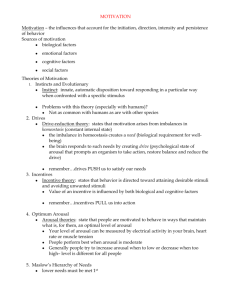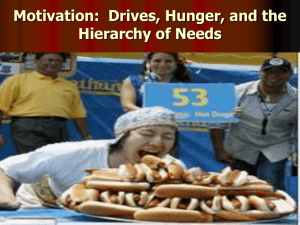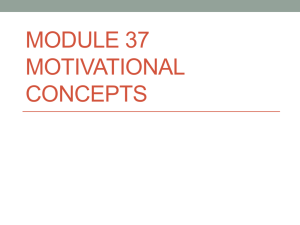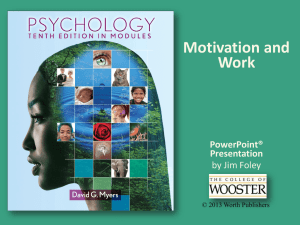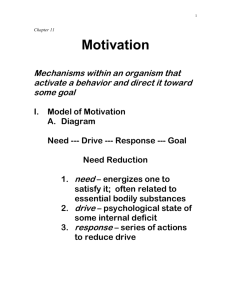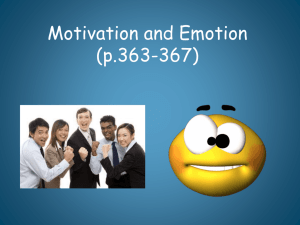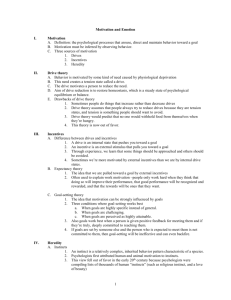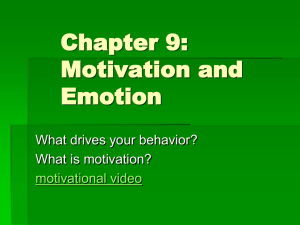Chapter 12 Motivation pt. 1
advertisement
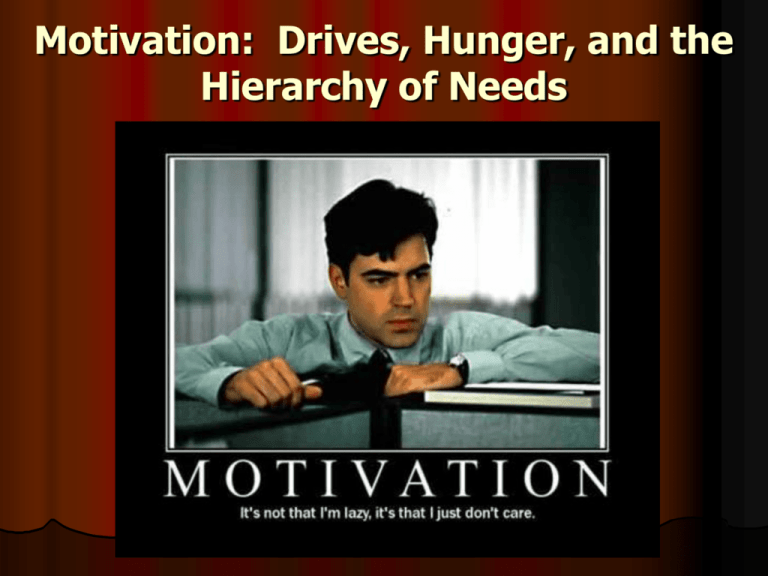
Motivation: Drives, Hunger, and the Hierarchy of Needs Motivation Guides Behavior Motivation: is a need or desire that serves to energize behavior. Behavior is guided by both physiological and psychological needs/desires. What types of things motivate us? major theories of MOTIVATION •Instinct / Evolutionary Perspective •Drive Reduction •Incentive •Arousal Theory •Maslow’s hierarchy of needs Instinct (Motivational Theory 1) Refers to inherited patterns of behavior that are unlearned. Mostly common in species outside of humans. Ex: Imprinting (Lorenz) Instinct (Motivational Theory 1) Pros and cons of this theory in explaining human behavior + Provides survival value – Doesn’t meet the complexity of most human behavior Internal Motivation How do you know when it is time for a glass of water? This Feeling of Thirstiness Creates a Drive Drive: type of motivation that is experienced as an aroused state of psychological /physiological tension caused by some need. Ex: Sex Drive Drives motivate us to do something. The goal of our body according to some psychologists, is to ELIMINATE all drives so that we can experience homeostasis: a balanced or constant internal state that the body regulates. Drive Reduction Theory (Motivational Theory 2) Drive Reduction Theory: idea that physiological (biological) needs create tension states (drives) which motivates organism to satisfy the need. Ex: Thirstiness (physiological need) creates tension state (drive) which motivates you to get water. After you drink, the drive is reduced and you are closer to homeostasis. Drive Reduction Theory (Motivational Theory 2) Pros and cons of this theory in explaining human behavior + Primary drives satisfied + Homeostasis for bio needs – Does not account for secondary motives Drive Reduction Theory (Motivational Theory 2) Examples of secondary motives: curiosity sensation seeking play achievement affiliation power Drive Reduction Theory does not account for any of these! Drive Reduction Theory in Action Incentives Theory (Motivational Theory 3) Incentives Theory: a positive or negative ENVIRONMENTAL (has to be external) stimulus that motivates behavior apart from the “need” to reduce drives. Ex: money, etc. Incentives Theory (Motivational Theory 3) Pros and cons of this theory in explaining human behavior + Secondary drives satisfied – Does not account for primary motives Contrasting approaches Drive reduction theory Incentive theory • “push” • “pull” • 5 hours since last meal • Ice cream truck • Hunger • Palatability (good • internal • external tasting) Arousal Theory (Motivational Theory 4) Based on 2 basic ideas: Individuals perform tasks at different levels of arousal (wakefulness/stress). Each individual seeks to find its optimal level of arousal to perform tasks and to avoid boredom. People with high levels of optimal arousal may be more susceptible to thrill seeking activities while those with low levels may seek out more relaxing quiet activities. We are motivated to do some things to maintain our arousal. Babies Explore their surroundings out of curiosity. Monkeys Illustrating Optimal Arousal Optimal Arousal Theory Continued Yerkes-Dodson Principle of Arousal: (graph forms an inverted-U) which states basic/general tasks are completed best with a moderate level of arousal. Inverted-U Graph only Relates to General/Basic Tasks (Yerkes-Dodson) What level of arousal is optimal for most individuals when they are completing DIFFICULT/SKILL BASED TASKS? (McGraw Hill, p. 148) Low to Medium level of arousal What level of arousal is optimal for most individuals when they are completing EASY/EFFORT BASED TASKS? High level of arousal Arousal and Performance Performance level Low Arousal High Maslow’s Hierarchy of Needs (Motivation Theory 5) Physical Needs at bottom must be met first. Psychological goals come after…ultimate goal is self actualization. Quick Review: Why Do We Eat? Incentive Drive Theory would argue: Reduction Theory would argue: Optimal Arousal Theory would argue: Biological Theories of Hunger Stomach contractions (hunger pangs) accompany our feelings of hunger. Subject swallows balloon, which measures stomach contraction Subject presses key each time when hungry Stomach contractions Hunger pangs 0 1 2 3 4 5 6 7 8 9 10 Time in minutes What does this experiment show us? Biological Basis of Hunger Hunger does NOT come from our stomach. It comes from our… Brain What part of the brain? The Hypothalamus Body Chemistry’s Influence on Hunger Glucose: blood sugar that provides energy to the body tissues. When your glucose levels are LOW you will feel hungry, when glucose levels are HIGH you will feel full. The hormone insulin is the primary regulator of glucose levels. Without insulin the body does not effectively dispose of glucose and provide it as energy (diabetes). Hypothalamus Lateral Hypothalamus When stimulated it makes you hungry. When lesioned (destroyed) you will never be hungry again. Ventromedial Hypothalamus When stimulated you feel full. When lesioned you will never feel full again. Hypothalamus How do I keep this lateral/ventromedial stuff straight? Remember: LLL – Lateral, Lesion, Lean The Mystery of the Fat Rat Potential Causes? Brain Chemical that Affects Hunger Leptin: is a protein produced by bloated fat cells; when these levels rise the body tells you to stop eating and pursue some type of activity. Mice Experiment Neurotransmitters Influence on Hunger Like glucose, if the following neurotransmitters are at low levels you will feel hungry, and if they are at high levels you will feel full: Norepinephrine Dopamine Serotonin Genetic Influences on Hunger/Weight 1. Number of fat cells is determined by genetics to a certain extent. 2. Set Point: body’s ideal weight set by its “weight thermostat.” When body falls below weight; hunger increases and a lowered metabolic rate continues. 3. Basal Metabolic Rate (metabolism): body’s resting rate of energy expenditure. Some individuals’ metabolisms are much higher than others. Obesity Theory #1: Obesity and Set point (genetic) Eat more to feel satisfied Obese Person Higher set point If eat less, become very sensitive to external cues Set Point theory Set Point ------- # of fat cells Size of cells Body weight Gaining weight Increase in body weight Increase in # and size of fat cells Raises set point # of fat cells Size of cells Body weight Losing weight No decrease in # of fat cells Decrease in cell size set point doesn’t drop # of fat cells Size of cells Body weight Obesity Theory #2: Obesity and External Cues (Environment) Oversensitivity to external cues Based on social convention (Sight, availability, time of day) Obesity Insensitivity to internal cues (stomach contractions) Other external cues Eat by the clock Sight of other people eating Social settings Obesity Theory #3: Obesity and Settling point (Genetics and Environment) Rapid rise in obesity in USA 10% population in 1980, 31% in 1991 Cultural differences in diet Fast food nation Advice from weight loss experts There is no easy route to wt loss Permanent changes in your lifestyle Set reasonable goals Exercise: critical factor in long run Avoid fad diets Don’t feel guilty Time’s Affect on Hunger Memory of our last meal can also affect hunger along with our schedule of when we usually eat. Ex. Amnesia Patients who cannot remember their last meal with readily eat another meal soon after the previous one. Learning (External Environment) and Hunger If good eating habits are positively reinforced and bad habits punished, children will often eat healthy. Type of conditioning? People can also develop taste aversions due to certain associations. Ex: chemotherapy patients. Modeling: imitation of healthy or poor eating habits can effect a child’s eating. Ex: Parents Eat Junk Food Culture’s Influence on Eating Although our preferences for sweet and salty foods are genetic and universal, our culture’s eating norms affect our specific eating habits. Monkey Stew is a popular dish in some Eastern cultures. This steak would seem repulsive to eat to most Hindus. Reinforcements Influence on Eating Example: May finish your vegetables to stop your mom from nagging you or to make your grandma happy. If you eat broccoli, you get dessert Culture’s Influence on Eating (disorders) Many argue the impossible standards of beauty put out by popular culture has lead to an increase in eating disorders: Anorexia Nervosa: eating disorder in which a normal-weight person diets and becomes significantly underweight, yet still feels fat and starves themselves. Bulimia Nervosa: an eating disorder usually characterized by excessive eating followed by vomiting. Culture’s Influence on Eating (disorders) Which eating disorder is characterized in this picture? Changing Beauty Standards Correlate with Eating Disorders IDEAL UNTIL 1900S MARILYN MONROE KATE MOSS Women’s Distorted Ideals of Body Image Thinnest Women’s ideal What women What men believed men actually preferred preferred Women’s current body image Fattest
